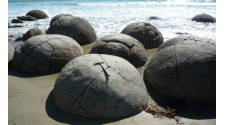
Richard Metcalfe has assisted with geochemical interpretations during a study into the formation mechanism of spherical carbonate concretions.
Roughly spherical masses composed predominantly of carbonate minerals, termed “carbonate concretions”, occur in fine grained rocks at many locations throughout the world and often contain spectacular fossils. For many years, scientists have sought to answer several important questions regarding such concretions: What conditions cause them to form? Why do they often form around dead organisms? How long do they take to grow? Why do they stop growing? Why do they have sharp boundaries, making them so distinct from the surrounding rock or sediments?
In a recent study reported in Nature Scientific Reports, researchers, led by Prof. Hidekazu Yoshida of Nagoya University, developed a method to analyse concretions using L-shaped "cross-plot diagrams" relating diffusion and growth rate. They applied the method to dozens of concretions from three sites across Japan, England and New Zealand.
This new study showed that concretions can grow at a very fast rate over several months to several years. This rapid growth effectively seals a volume of sediment and could explain why some concretions contain well-preserved fossils of soft tissues that are rarely fossilised under other circumstances.
The investigated concretions were all composed of calcite, with compositions that vary little, and were clearly separated from the surrounding muddy matrices by well-defined margins. Each margin represents a front at which dissolved bicarbonate in the porewater within the concretion reacts with calcium dissolved in porewater in the surrounding muddy matrix. A relatively high bicarbonate concentration in the porewater inside a concretion originates from the breakdown of organic acids produced by the decay of a dead organism. The sharp boundary of a concretion reflects the limited diffusion rate of solutes in porewaters within the fine-grained sediments. According to the study, the more permeable a sedimentary matrix, the less well-defined will be the margins of a concretion. This explains why well-defined concretions are not typically found in coarser and more permeable sediments.
This new model for the creation of spherical concretions can be applied to interpret concretions from all over the world. In addition to advancing our knowledge of this important preservation mechanism in the fossil record, this improved understanding of the rapid precipitation of calcite due to the presence of organic material may have practical applications in the field of rock sealing technology for underground activities.

Lead image- Moeraki boulders: Gigantic concretions formed in mudstone on New Zealand's Moeraki coast; about 50 million years old. The present research shows that even concretions of this size could have formed very rapidly, within several decades. © H. Yoshida.